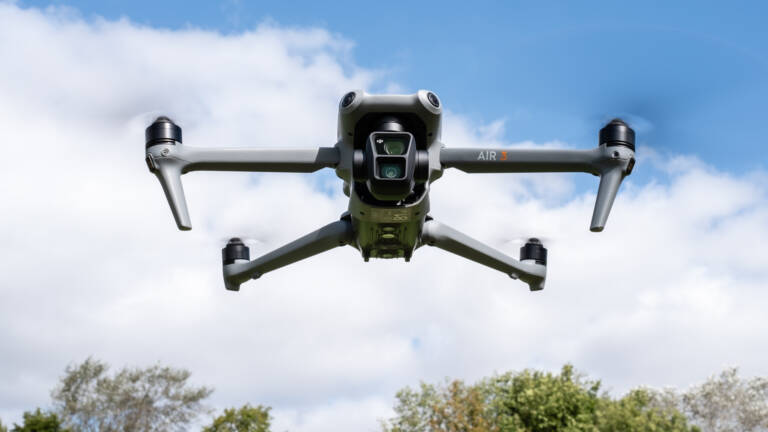Strategic weakness: The US could only fight a drone war using Chinese drones

When Russia invaded Ukraine in early 2022, military and government experts seemed certain that Ukraine would not be able to repel the numerically superior Russian military. What they had not considered were the Ukrainian drones and the innovative tactics applied in their use.
For the first time in the history of conflict, drones have been deployed and made accessible to nearly every soldier on the battlefield, and the effects have been remarkable. From reconnaissance missions to artillery targeting and munitions deployment, drones have proven to be a radical force multiplier capable of influencing the course of a war.
Recent estimates suggest that Ukraine consumes over 10,000 drones per month . These drones cover the entire spectrum of size, speed, and capability, but the vast majority are off-the-shelf models from a single company: Chinese drone manufacturer DJI.
Ukraine's ingenuity in exploiting these systems is impressive, but it highlights the world's overwhelming dependence on China as a leading drone manufacturer.
DJI and Autel, both based in Shenzhen, produce more than 90 percent of the world's drones. Almost the entire drone industry is based in that city, from finished products to components.
China's dominance in drone manufacturing has been deliberately cultivated through aggressive government subsidies, direct investment, and strategic regulations to develop a domestic industry and gain a technological advantage.
This government funding also allowed DJI to engage in anticompetitive pricing tactics that contributed to the closure of early U.S. drone companies such as GoPro's drone division, 3D Robotics , and, more recently, Skydio 's end-consumer-level business.
This state-led approach has made China the world's drone factory and created a dangerous imbalance in the global supply chain. Beijing has near-total control over a vital tool in both modern warfare and domestic security use cases. A sensational mistake that Western countries were unable to prevent.
Now five of the ten main drone manufacturers are Chinese and above all some of the largest are Chinese. The United States cannot easily scale production to produce the volumes of drones that Ukraine consumes monthly, let alone the numbers needed to supply its own military if it wanted to adopt Ukrainian drone tactics.
Right now, the United States could only quickly equip its military by purchasing from its largest strategic adversary, because even major European, especially French, manufacturers are secondary. The risks from a data and supply chain security perspective are extreme, especially considering the record of these companies.
DJI, dubbed a “Chinese Military Company” by the Department of Defense, was caught sending data to China and hiding its Chinese government roots. The company has also been accused of limiting Ukraine's access to its drone tracking tools, while boosting Russian forces and implementing a geo-fencing system that could easily be extended to limit U.S.-based hardware .
China's second-largest drone maker, Autel, doesn't have a much better record, rebranding its drones with the "Patriot" name before selling them to Russian forces.
In August, the Department of Defense announced the “Replicator Initiative,” an initiative to purchase thousands of aerial drones and other autonomous devices over the next two years. This is a great start, but the quantity of drones estimated to be produced as a result of the initiative would only last Ukraine a week of autonomy.
To keep pace on this critical dual-use technology, the Department of Defense must establish programs to purchase hundreds of thousands of drones and invest in manufacturing capacity in the United States and allied countries.
In the current manufacturing environment, drones in the United States are built by hand. In China, they are built from automated production lines, take off autonomously at the end of the line, fly through an obstacle course to ensure quality, and land in their own box to be shipped to customers. We need to completely rethink production lines.
The United States is optimistically five years behind its Chinese competitors. In addition to factories, investments need to be directed towards some underlying technologies. Custom silicon for drones massively impacts performance, and China's high-bandwidth, low-latency radio controllers, flight computers and thermal imaging are not matched by US alternatives in terms of capability or cost.
The only solution is investment along the entire drone supply chain. An enormous economic commitment and not accompanied, for now, by any real market demand. Private individuals are moving very slowly in this direction and demand is very low. Only a process of opening new markets could lead to the creation of a truly national drone industry.

Thanks to our Telegram channel you can stay updated on the publication of new Economic Scenarios articles.
The article Strategic Weakness: US Could Fight a Drone War Only Using Chinese Drones comes from Economic Scenarios .
This is a machine translation of a post published on Scenari Economici at the URL https://scenarieconomici.it/debolezza-strategica-gli-usa-potrebbero-combattere-una-guerra-coi-droni-solo-usando-i-droni-cinesi/ on Mon, 16 Oct 2023 06:00:26 +0000.
